Essay: Developing a Wellness Action Plan for Self-Care and Resilience
VerifiedAdded on 2022/09/06
|10
|2732
|13
Essay
AI Summary
This essay delves into the critical concepts of self-care and resilience within the context of healthcare, particularly for nursing associates. It begins by defining self-care and resilience, highlighting their significance in managing stress and promoting overall wellbeing. The essay then explores various factors and lifestyle choices that influence personal fitness and wellbeing, including physical activity, diet, and relaxation techniques. It examines the responsibilities of nursing associates in relation to their personal health and wellbeing, emphasizing the need for self-care to effectively meet patient needs. The core of the essay involves the development of a Wellness Action Plan (WAP), a recovery model designed to identify strategies for self-care and resilience. The WAP includes practical steps such as hydration, manager support, addressing poor mental health triggers, early warning signs, and self-care strategies. The essay concludes by summarizing the benefits of self-care and resilience for nursing staff, emphasizing the importance of these practices in enhancing quality of care and providing empathy during adverse events.
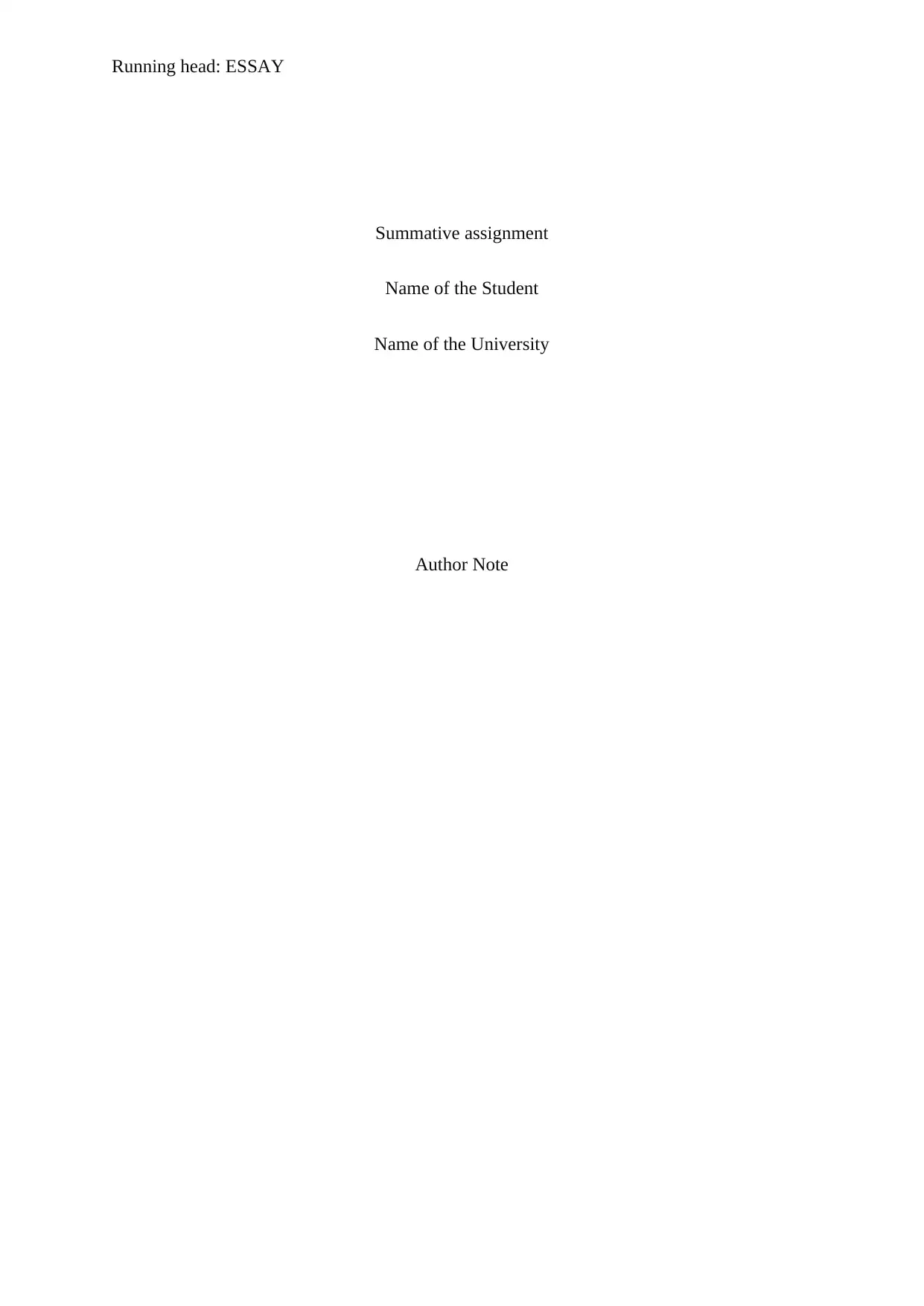
Running head: ESSAY
Summative assignment
Name of the Student
Name of the University
Author Note
Summative assignment
Name of the Student
Name of the University
Author Note
Paraphrase This Document
Need a fresh take? Get an instant paraphrase of this document with our AI Paraphraser
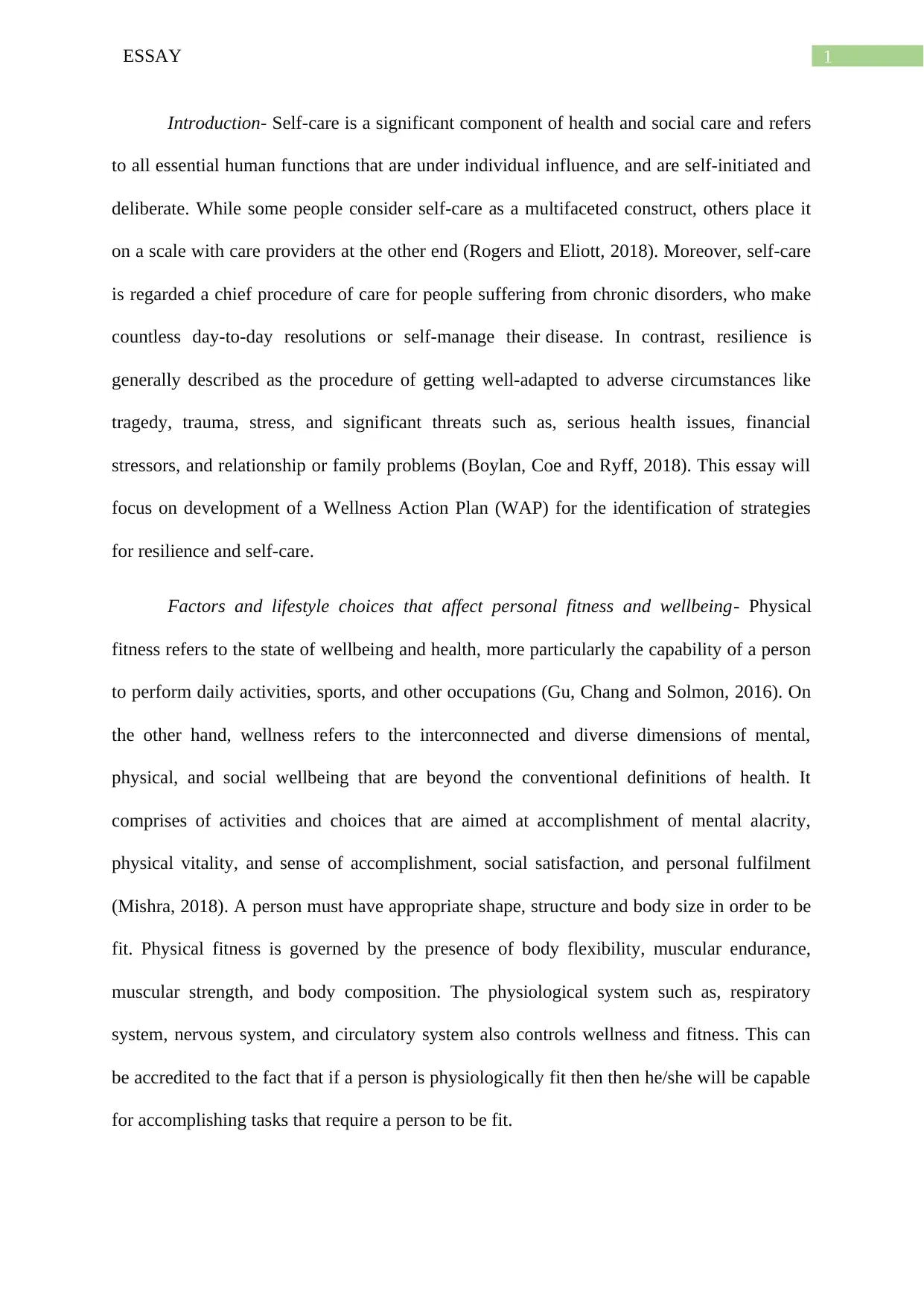
1ESSAY
Introduction- Self-care is a significant component of health and social care and refers
to all essential human functions that are under individual influence, and are self-initiated and
deliberate. While some people consider self-care as a multifaceted construct, others place it
on a scale with care providers at the other end (Rogers and Eliott, 2018). Moreover, self-care
is regarded a chief procedure of care for people suffering from chronic disorders, who make
countless day-to-day resolutions or self-manage their disease. In contrast, resilience is
generally described as the procedure of getting well-adapted to adverse circumstances like
tragedy, trauma, stress, and significant threats such as, serious health issues, financial
stressors, and relationship or family problems (Boylan, Coe and Ryff, 2018). This essay will
focus on development of a Wellness Action Plan (WAP) for the identification of strategies
for resilience and self-care.
Factors and lifestyle choices that affect personal fitness and wellbeing- Physical
fitness refers to the state of wellbeing and health, more particularly the capability of a person
to perform daily activities, sports, and other occupations (Gu, Chang and Solmon, 2016). On
the other hand, wellness refers to the interconnected and diverse dimensions of mental,
physical, and social wellbeing that are beyond the conventional definitions of health. It
comprises of activities and choices that are aimed at accomplishment of mental alacrity,
physical vitality, and sense of accomplishment, social satisfaction, and personal fulfilment
(Mishra, 2018). A person must have appropriate shape, structure and body size in order to be
fit. Physical fitness is governed by the presence of body flexibility, muscular endurance,
muscular strength, and body composition. The physiological system such as, respiratory
system, nervous system, and circulatory system also controls wellness and fitness. This can
be accredited to the fact that if a person is physiologically fit then then he/she will be capable
for accomplishing tasks that require a person to be fit.
Introduction- Self-care is a significant component of health and social care and refers
to all essential human functions that are under individual influence, and are self-initiated and
deliberate. While some people consider self-care as a multifaceted construct, others place it
on a scale with care providers at the other end (Rogers and Eliott, 2018). Moreover, self-care
is regarded a chief procedure of care for people suffering from chronic disorders, who make
countless day-to-day resolutions or self-manage their disease. In contrast, resilience is
generally described as the procedure of getting well-adapted to adverse circumstances like
tragedy, trauma, stress, and significant threats such as, serious health issues, financial
stressors, and relationship or family problems (Boylan, Coe and Ryff, 2018). This essay will
focus on development of a Wellness Action Plan (WAP) for the identification of strategies
for resilience and self-care.
Factors and lifestyle choices that affect personal fitness and wellbeing- Physical
fitness refers to the state of wellbeing and health, more particularly the capability of a person
to perform daily activities, sports, and other occupations (Gu, Chang and Solmon, 2016). On
the other hand, wellness refers to the interconnected and diverse dimensions of mental,
physical, and social wellbeing that are beyond the conventional definitions of health. It
comprises of activities and choices that are aimed at accomplishment of mental alacrity,
physical vitality, and sense of accomplishment, social satisfaction, and personal fulfilment
(Mishra, 2018). A person must have appropriate shape, structure and body size in order to be
fit. Physical fitness is governed by the presence of body flexibility, muscular endurance,
muscular strength, and body composition. The physiological system such as, respiratory
system, nervous system, and circulatory system also controls wellness and fitness. This can
be accredited to the fact that if a person is physiologically fit then then he/she will be capable
for accomplishing tasks that require a person to be fit.

2ESSAY
According to Kuosmanen et al. (2016) levels of physical fitness and wellbeing
dramatically decline with age. With an increase in age, there occurs a reduction in maximum
exercise capacity and muscle activity. Moreover, not only does an advancing age compromise
physical capabilities, but also affects mental functions, thus preventing people from being
self-sufficient. In addition, aging also leads to a decreased production of T cells and B cells in
thymus and bone marrow, thereby preventing them from responding to immune challenges,
and deteriorating wellbeing (Qin et al., 2016). Additionally, there are several health risks that
are more common amid males, compared to females. Genes, anatomy, and hormones increase
the risk of cardiovascular disease, autism, Parkinson’s disease and pancreatitis among males
(Espnes, Nguyen and Byrne, 2016). In contrast, women are more susceptible to stroke,
osteoporosis, multiple sclerosis, urinary tract infection, and dementia (Amouzougan et al.,
2017).
Diet and exercise are major lifestyle factors that ensure fitness. Cardiorespiratory
fitness is generally assessed by determining the amount of oxygen that can be taken and
utilised by the body. People who perform aerobic exercise are more fit since it enhances
cardiorespiratory fitness, owing to the involvement of movement, which in turn augments
heart rate (Stubbs et al., 2016). This eventually improves oxygen consumption of the body
and also increases stamina. Some common aerobic exercises that lead to fitness are namely,
jogging, elliptical training, walking, swimming, treadmill training, and cycling. Likewise,
anaerobic exercise also helps people to remain fit by triggering the formation of lactate. This
form of exercise is generally performed by athletes, particularly in non-endurance sports,
with the aim of promoting speed, strength and power (Birnbaumer et al., 2018). Consuming a
well-balanced diet helps individuals to obtain the essential nutrients and calories that are
imperative for fuelling daily activities. A healthy diet has often been correlated with reduced
risk of diabetes, obesity, and cardiovascular disorders. Moreover, it also helps in complete
According to Kuosmanen et al. (2016) levels of physical fitness and wellbeing
dramatically decline with age. With an increase in age, there occurs a reduction in maximum
exercise capacity and muscle activity. Moreover, not only does an advancing age compromise
physical capabilities, but also affects mental functions, thus preventing people from being
self-sufficient. In addition, aging also leads to a decreased production of T cells and B cells in
thymus and bone marrow, thereby preventing them from responding to immune challenges,
and deteriorating wellbeing (Qin et al., 2016). Additionally, there are several health risks that
are more common amid males, compared to females. Genes, anatomy, and hormones increase
the risk of cardiovascular disease, autism, Parkinson’s disease and pancreatitis among males
(Espnes, Nguyen and Byrne, 2016). In contrast, women are more susceptible to stroke,
osteoporosis, multiple sclerosis, urinary tract infection, and dementia (Amouzougan et al.,
2017).
Diet and exercise are major lifestyle factors that ensure fitness. Cardiorespiratory
fitness is generally assessed by determining the amount of oxygen that can be taken and
utilised by the body. People who perform aerobic exercise are more fit since it enhances
cardiorespiratory fitness, owing to the involvement of movement, which in turn augments
heart rate (Stubbs et al., 2016). This eventually improves oxygen consumption of the body
and also increases stamina. Some common aerobic exercises that lead to fitness are namely,
jogging, elliptical training, walking, swimming, treadmill training, and cycling. Likewise,
anaerobic exercise also helps people to remain fit by triggering the formation of lactate. This
form of exercise is generally performed by athletes, particularly in non-endurance sports,
with the aim of promoting speed, strength and power (Birnbaumer et al., 2018). Consuming a
well-balanced diet helps individuals to obtain the essential nutrients and calories that are
imperative for fuelling daily activities. A healthy diet has often been correlated with reduced
risk of diabetes, obesity, and cardiovascular disorders. Moreover, it also helps in complete
⊘ This is a preview!⊘
Do you want full access?
Subscribe today to unlock all pages.

Trusted by 1+ million students worldwide
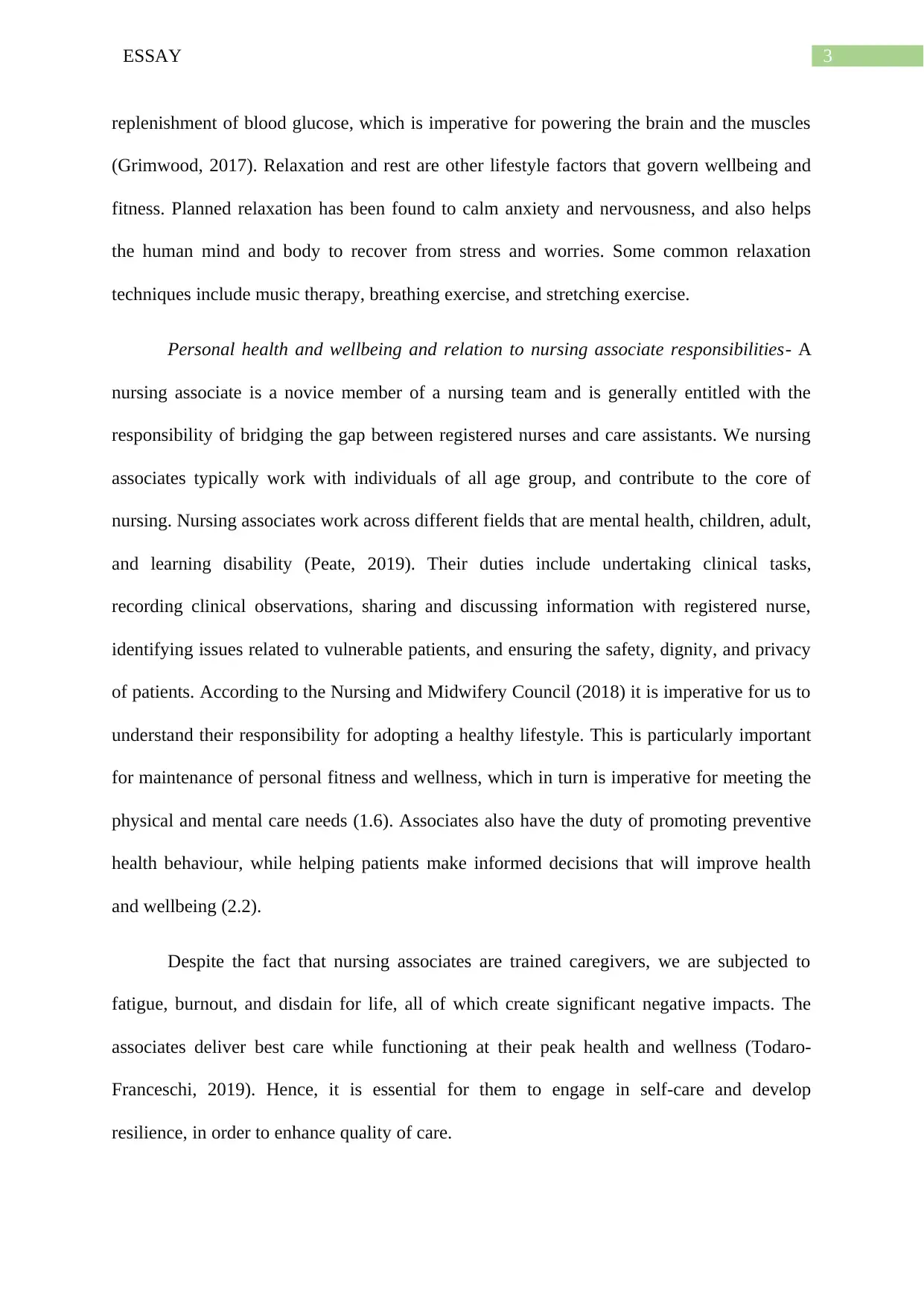
3ESSAY
replenishment of blood glucose, which is imperative for powering the brain and the muscles
(Grimwood, 2017). Relaxation and rest are other lifestyle factors that govern wellbeing and
fitness. Planned relaxation has been found to calm anxiety and nervousness, and also helps
the human mind and body to recover from stress and worries. Some common relaxation
techniques include music therapy, breathing exercise, and stretching exercise.
Personal health and wellbeing and relation to nursing associate responsibilities- A
nursing associate is a novice member of a nursing team and is generally entitled with the
responsibility of bridging the gap between registered nurses and care assistants. We nursing
associates typically work with individuals of all age group, and contribute to the core of
nursing. Nursing associates work across different fields that are mental health, children, adult,
and learning disability (Peate, 2019). Their duties include undertaking clinical tasks,
recording clinical observations, sharing and discussing information with registered nurse,
identifying issues related to vulnerable patients, and ensuring the safety, dignity, and privacy
of patients. According to the Nursing and Midwifery Council (2018) it is imperative for us to
understand their responsibility for adopting a healthy lifestyle. This is particularly important
for maintenance of personal fitness and wellness, which in turn is imperative for meeting the
physical and mental care needs (1.6). Associates also have the duty of promoting preventive
health behaviour, while helping patients make informed decisions that will improve health
and wellbeing (2.2).
Despite the fact that nursing associates are trained caregivers, we are subjected to
fatigue, burnout, and disdain for life, all of which create significant negative impacts. The
associates deliver best care while functioning at their peak health and wellness (Todaro-
Franceschi, 2019). Hence, it is essential for them to engage in self-care and develop
resilience, in order to enhance quality of care.
replenishment of blood glucose, which is imperative for powering the brain and the muscles
(Grimwood, 2017). Relaxation and rest are other lifestyle factors that govern wellbeing and
fitness. Planned relaxation has been found to calm anxiety and nervousness, and also helps
the human mind and body to recover from stress and worries. Some common relaxation
techniques include music therapy, breathing exercise, and stretching exercise.
Personal health and wellbeing and relation to nursing associate responsibilities- A
nursing associate is a novice member of a nursing team and is generally entitled with the
responsibility of bridging the gap between registered nurses and care assistants. We nursing
associates typically work with individuals of all age group, and contribute to the core of
nursing. Nursing associates work across different fields that are mental health, children, adult,
and learning disability (Peate, 2019). Their duties include undertaking clinical tasks,
recording clinical observations, sharing and discussing information with registered nurse,
identifying issues related to vulnerable patients, and ensuring the safety, dignity, and privacy
of patients. According to the Nursing and Midwifery Council (2018) it is imperative for us to
understand their responsibility for adopting a healthy lifestyle. This is particularly important
for maintenance of personal fitness and wellness, which in turn is imperative for meeting the
physical and mental care needs (1.6). Associates also have the duty of promoting preventive
health behaviour, while helping patients make informed decisions that will improve health
and wellbeing (2.2).
Despite the fact that nursing associates are trained caregivers, we are subjected to
fatigue, burnout, and disdain for life, all of which create significant negative impacts. The
associates deliver best care while functioning at their peak health and wellness (Todaro-
Franceschi, 2019). Hence, it is essential for them to engage in self-care and develop
resilience, in order to enhance quality of care.
Paraphrase This Document
Need a fresh take? Get an instant paraphrase of this document with our AI Paraphraser
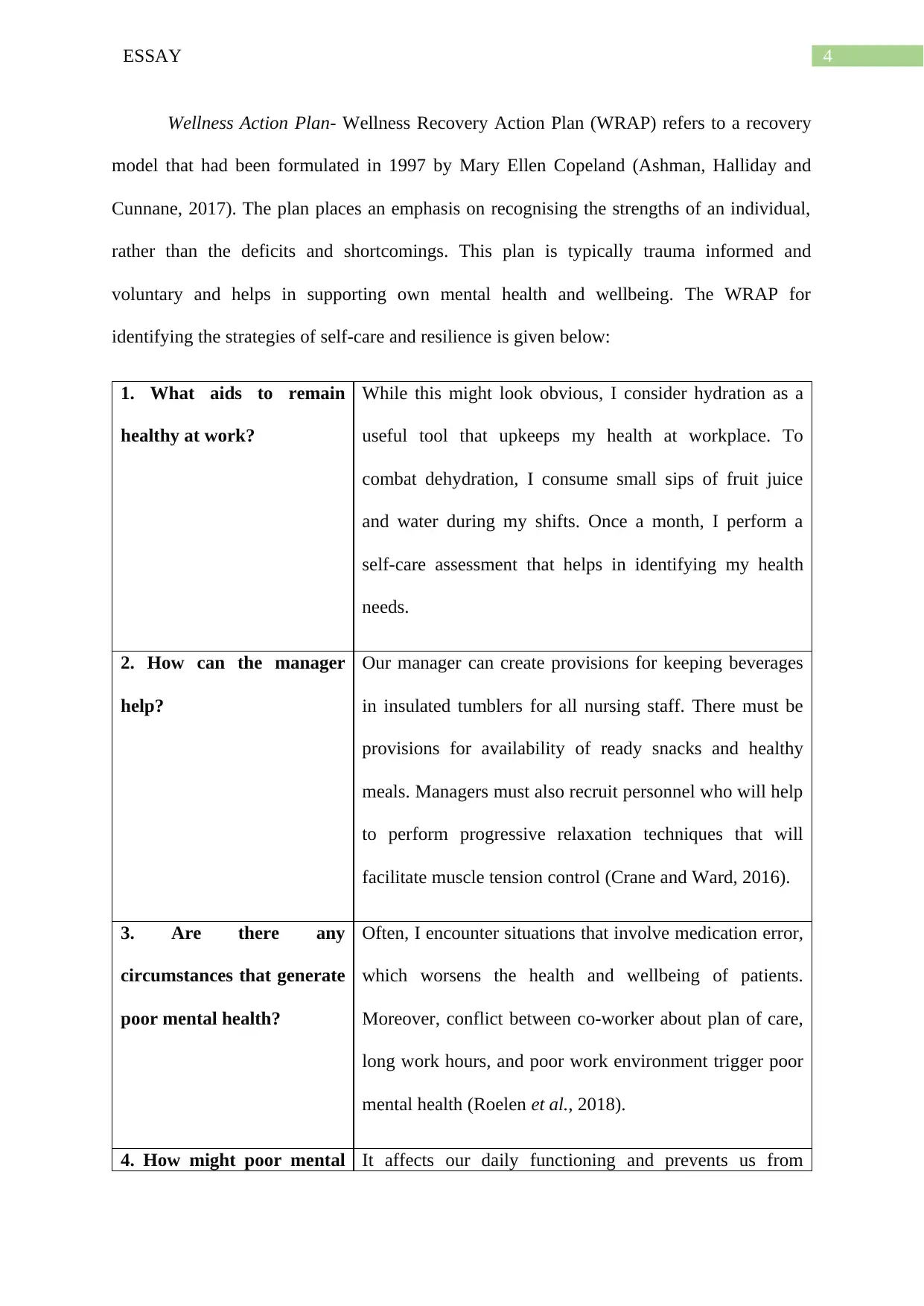
4ESSAY
Wellness Action Plan- Wellness Recovery Action Plan (WRAP) refers to a recovery
model that had been formulated in 1997 by Mary Ellen Copeland (Ashman, Halliday and
Cunnane, 2017). The plan places an emphasis on recognising the strengths of an individual,
rather than the deficits and shortcomings. This plan is typically trauma informed and
voluntary and helps in supporting own mental health and wellbeing. The WRAP for
identifying the strategies of self-care and resilience is given below:
1. What aids to remain
healthy at work?
While this might look obvious, I consider hydration as a
useful tool that upkeeps my health at workplace. To
combat dehydration, I consume small sips of fruit juice
and water during my shifts. Once a month, I perform a
self-care assessment that helps in identifying my health
needs.
2. How can the manager
help?
Our manager can create provisions for keeping beverages
in insulated tumblers for all nursing staff. There must be
provisions for availability of ready snacks and healthy
meals. Managers must also recruit personnel who will help
to perform progressive relaxation techniques that will
facilitate muscle tension control (Crane and Ward, 2016).
3. Are there any
circumstances that generate
poor mental health?
Often, I encounter situations that involve medication error,
which worsens the health and wellbeing of patients.
Moreover, conflict between co-worker about plan of care,
long work hours, and poor work environment trigger poor
mental health (Roelen et al., 2018).
4. How might poor mental It affects our daily functioning and prevents us from
Wellness Action Plan- Wellness Recovery Action Plan (WRAP) refers to a recovery
model that had been formulated in 1997 by Mary Ellen Copeland (Ashman, Halliday and
Cunnane, 2017). The plan places an emphasis on recognising the strengths of an individual,
rather than the deficits and shortcomings. This plan is typically trauma informed and
voluntary and helps in supporting own mental health and wellbeing. The WRAP for
identifying the strategies of self-care and resilience is given below:
1. What aids to remain
healthy at work?
While this might look obvious, I consider hydration as a
useful tool that upkeeps my health at workplace. To
combat dehydration, I consume small sips of fruit juice
and water during my shifts. Once a month, I perform a
self-care assessment that helps in identifying my health
needs.
2. How can the manager
help?
Our manager can create provisions for keeping beverages
in insulated tumblers for all nursing staff. There must be
provisions for availability of ready snacks and healthy
meals. Managers must also recruit personnel who will help
to perform progressive relaxation techniques that will
facilitate muscle tension control (Crane and Ward, 2016).
3. Are there any
circumstances that generate
poor mental health?
Often, I encounter situations that involve medication error,
which worsens the health and wellbeing of patients.
Moreover, conflict between co-worker about plan of care,
long work hours, and poor work environment trigger poor
mental health (Roelen et al., 2018).
4. How might poor mental It affects our daily functioning and prevents us from

5ESSAY
health affect work? critically thinking, while delivering care to patients. It
creates problems in concentration and communication, and
hinders effective time management. It causes lapse in
nursing judgment, medication error and delay in care.
5. Are there any early
warning signs?
Confused thinking, feeling sad, excessive worries or fear,
withdrawal from family and friends, insomnia, significant
exhaustion, and concentration problems (Bankat, Go'ar and
Dagona, 2017).
6. Can exercise can
restoring wellness and
health?
Strength and stamina are imperative for effectively
performing job duties. I have the notion that swimming,
walking, yoga and cycling, at least twice a week play a
significant role in enhancing health and wellbeing.
7. What are some other
effective self-care
strategies?
I often try to create a relaxing sleep environment and also
use ear plugs for preventing sleep disturbance. Following
mindfulness based techniques like guided imagery and
deep breathing exercise can also prove instrumental in
stress relief (Halm, 2017).
8. What helps in building
resilience at work?
Good association with co-workers and subordinates help in
development of connection. I accept support and help from
people who care about me. I try to assist others at the time
of need. I always trust my instincts and have gradually
developed confidence in my capabilities. Additionally, I
maintain a personal diary where I note down my deepest
health affect work? critically thinking, while delivering care to patients. It
creates problems in concentration and communication, and
hinders effective time management. It causes lapse in
nursing judgment, medication error and delay in care.
5. Are there any early
warning signs?
Confused thinking, feeling sad, excessive worries or fear,
withdrawal from family and friends, insomnia, significant
exhaustion, and concentration problems (Bankat, Go'ar and
Dagona, 2017).
6. Can exercise can
restoring wellness and
health?
Strength and stamina are imperative for effectively
performing job duties. I have the notion that swimming,
walking, yoga and cycling, at least twice a week play a
significant role in enhancing health and wellbeing.
7. What are some other
effective self-care
strategies?
I often try to create a relaxing sleep environment and also
use ear plugs for preventing sleep disturbance. Following
mindfulness based techniques like guided imagery and
deep breathing exercise can also prove instrumental in
stress relief (Halm, 2017).
8. What helps in building
resilience at work?
Good association with co-workers and subordinates help in
development of connection. I accept support and help from
people who care about me. I try to assist others at the time
of need. I always trust my instincts and have gradually
developed confidence in my capabilities. Additionally, I
maintain a personal diary where I note down my deepest
⊘ This is a preview!⊘
Do you want full access?
Subscribe today to unlock all pages.

Trusted by 1+ million students worldwide

6ESSAY
feelings and thoughts realted to stress at work.
9. What can nursing
managers do help associates
increase their resilience?
They can create provisions where nursing associates can
actively participate in faith-based organisation, support
groups, and civic groups, all of which will help to deal
with problematic situations.
10. What else can increase
resilience at workplace?
Development of a set of realistic goals and placing due
emphasis on tasks that appear unachievable are two such
strategies. Acting on adverse situations and taking decisive
actions will also help in resilience development. There is a
need to maintain an optimistic outlook and pay attention to
own feelings and needs (Falavarjani and Yeh, 2019).
Table 1- WRAP
Conclusion- To conclude, self-care refers to any deliberate activities that are
performed, in an effort to improve mental, physical, and spiritual wellbeing. It is beneficial
for professionals in different domain, however particularly for nursing staff, who spend
maximum time caring for their patients. Modern medicine emphasises on the close
association between preventive medicines with self-care. Resilience involves thoughts,
behaviours, and actions that can be developed and learned, in the face of adversity. Poor
compliance to prescribed medications or other medical recommendations result in the onset
and progress of illness, thus increasing difficulty of self-care. The strategies identified in the
WRAP will not only reduce stress, but will also increasing capacity of nursing associates to
provide empathy and compassion, while facing adverse events and enhancing the quality of
care.
feelings and thoughts realted to stress at work.
9. What can nursing
managers do help associates
increase their resilience?
They can create provisions where nursing associates can
actively participate in faith-based organisation, support
groups, and civic groups, all of which will help to deal
with problematic situations.
10. What else can increase
resilience at workplace?
Development of a set of realistic goals and placing due
emphasis on tasks that appear unachievable are two such
strategies. Acting on adverse situations and taking decisive
actions will also help in resilience development. There is a
need to maintain an optimistic outlook and pay attention to
own feelings and needs (Falavarjani and Yeh, 2019).
Table 1- WRAP
Conclusion- To conclude, self-care refers to any deliberate activities that are
performed, in an effort to improve mental, physical, and spiritual wellbeing. It is beneficial
for professionals in different domain, however particularly for nursing staff, who spend
maximum time caring for their patients. Modern medicine emphasises on the close
association between preventive medicines with self-care. Resilience involves thoughts,
behaviours, and actions that can be developed and learned, in the face of adversity. Poor
compliance to prescribed medications or other medical recommendations result in the onset
and progress of illness, thus increasing difficulty of self-care. The strategies identified in the
WRAP will not only reduce stress, but will also increasing capacity of nursing associates to
provide empathy and compassion, while facing adverse events and enhancing the quality of
care.
Paraphrase This Document
Need a fresh take? Get an instant paraphrase of this document with our AI Paraphraser
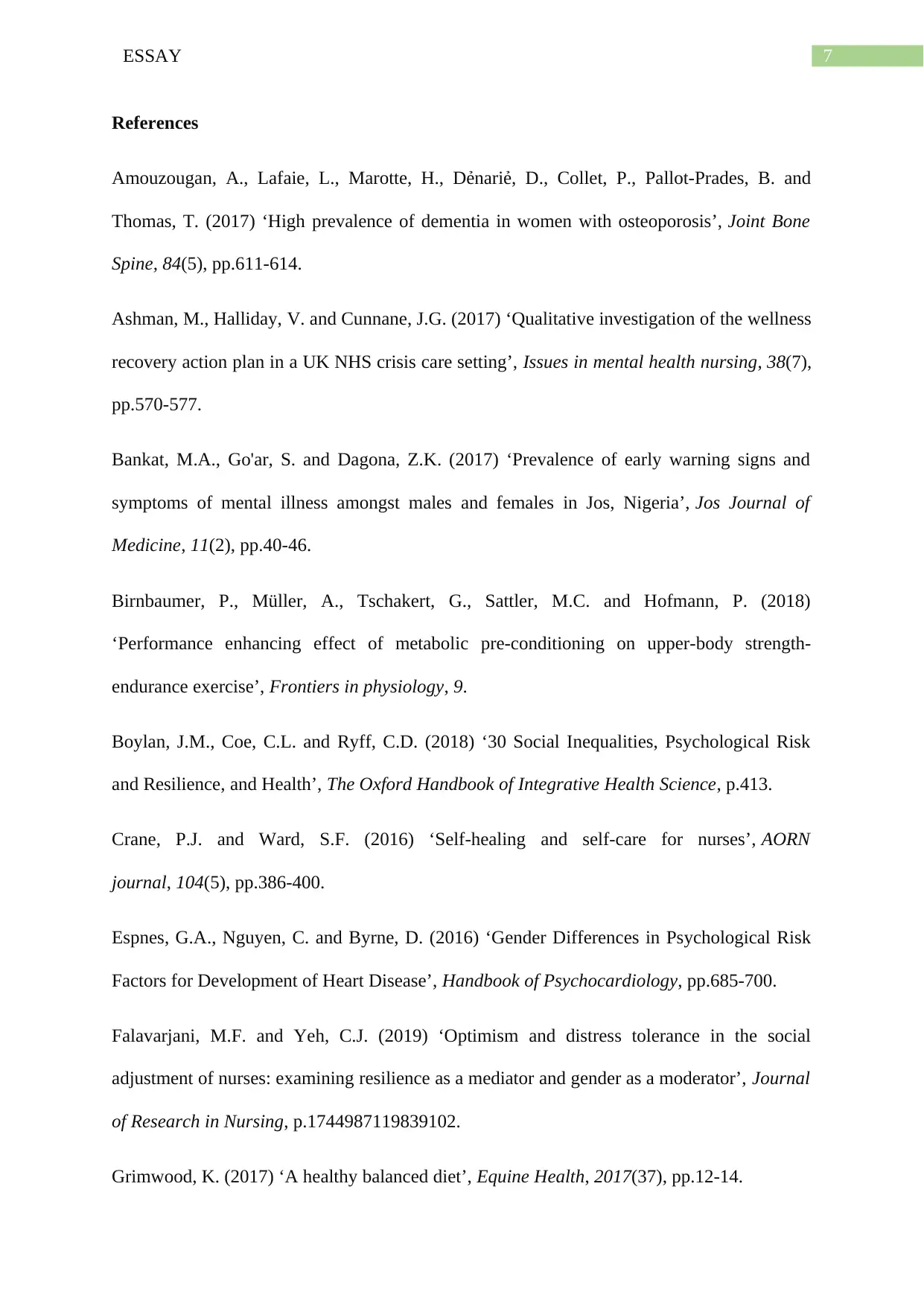
7ESSAY
References
Amouzougan, A., Lafaie, L., Marotte, H., Dẻnariẻ, D., Collet, P., Pallot-Prades, B. and
Thomas, T. (2017) ‘High prevalence of dementia in women with osteoporosis’, Joint Bone
Spine, 84(5), pp.611-614.
Ashman, M., Halliday, V. and Cunnane, J.G. (2017) ‘Qualitative investigation of the wellness
recovery action plan in a UK NHS crisis care setting’, Issues in mental health nursing, 38(7),
pp.570-577.
Bankat, M.A., Go'ar, S. and Dagona, Z.K. (2017) ‘Prevalence of early warning signs and
symptoms of mental illness amongst males and females in Jos, Nigeria’, Jos Journal of
Medicine, 11(2), pp.40-46.
Birnbaumer, P., Müller, A., Tschakert, G., Sattler, M.C. and Hofmann, P. (2018)
‘Performance enhancing effect of metabolic pre-conditioning on upper-body strength-
endurance exercise’, Frontiers in physiology, 9.
Boylan, J.M., Coe, C.L. and Ryff, C.D. (2018) ‘30 Social Inequalities, Psychological Risk
and Resilience, and Health’, The Oxford Handbook of Integrative Health Science, p.413.
Crane, P.J. and Ward, S.F. (2016) ‘Self-healing and self-care for nurses’, AORN
journal, 104(5), pp.386-400.
Espnes, G.A., Nguyen, C. and Byrne, D. (2016) ‘Gender Differences in Psychological Risk
Factors for Development of Heart Disease’, Handbook of Psychocardiology, pp.685-700.
Falavarjani, M.F. and Yeh, C.J. (2019) ‘Optimism and distress tolerance in the social
adjustment of nurses: examining resilience as a mediator and gender as a moderator’, Journal
of Research in Nursing, p.1744987119839102.
Grimwood, K. (2017) ‘A healthy balanced diet’, Equine Health, 2017(37), pp.12-14.
References
Amouzougan, A., Lafaie, L., Marotte, H., Dẻnariẻ, D., Collet, P., Pallot-Prades, B. and
Thomas, T. (2017) ‘High prevalence of dementia in women with osteoporosis’, Joint Bone
Spine, 84(5), pp.611-614.
Ashman, M., Halliday, V. and Cunnane, J.G. (2017) ‘Qualitative investigation of the wellness
recovery action plan in a UK NHS crisis care setting’, Issues in mental health nursing, 38(7),
pp.570-577.
Bankat, M.A., Go'ar, S. and Dagona, Z.K. (2017) ‘Prevalence of early warning signs and
symptoms of mental illness amongst males and females in Jos, Nigeria’, Jos Journal of
Medicine, 11(2), pp.40-46.
Birnbaumer, P., Müller, A., Tschakert, G., Sattler, M.C. and Hofmann, P. (2018)
‘Performance enhancing effect of metabolic pre-conditioning on upper-body strength-
endurance exercise’, Frontiers in physiology, 9.
Boylan, J.M., Coe, C.L. and Ryff, C.D. (2018) ‘30 Social Inequalities, Psychological Risk
and Resilience, and Health’, The Oxford Handbook of Integrative Health Science, p.413.
Crane, P.J. and Ward, S.F. (2016) ‘Self-healing and self-care for nurses’, AORN
journal, 104(5), pp.386-400.
Espnes, G.A., Nguyen, C. and Byrne, D. (2016) ‘Gender Differences in Psychological Risk
Factors for Development of Heart Disease’, Handbook of Psychocardiology, pp.685-700.
Falavarjani, M.F. and Yeh, C.J. (2019) ‘Optimism and distress tolerance in the social
adjustment of nurses: examining resilience as a mediator and gender as a moderator’, Journal
of Research in Nursing, p.1744987119839102.
Grimwood, K. (2017) ‘A healthy balanced diet’, Equine Health, 2017(37), pp.12-14.
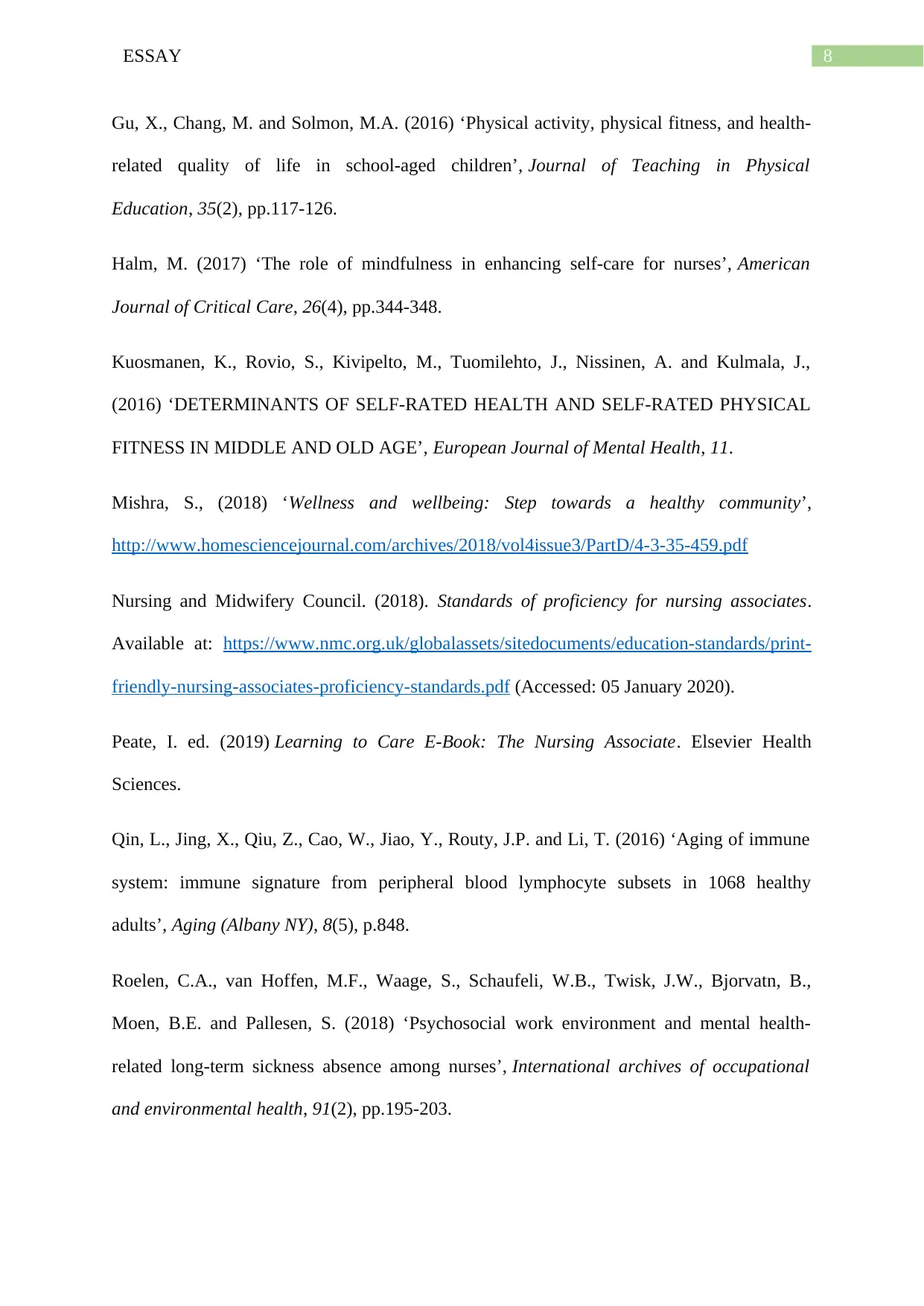
8ESSAY
Gu, X., Chang, M. and Solmon, M.A. (2016) ‘Physical activity, physical fitness, and health-
related quality of life in school-aged children’, Journal of Teaching in Physical
Education, 35(2), pp.117-126.
Halm, M. (2017) ‘The role of mindfulness in enhancing self-care for nurses’, American
Journal of Critical Care, 26(4), pp.344-348.
Kuosmanen, K., Rovio, S., Kivipelto, M., Tuomilehto, J., Nissinen, A. and Kulmala, J.,
(2016) ‘DETERMINANTS OF SELF-RATED HEALTH AND SELF-RATED PHYSICAL
FITNESS IN MIDDLE AND OLD AGE’, European Journal of Mental Health, 11.
Mishra, S., (2018) ‘Wellness and wellbeing: Step towards a healthy community’,
http://www.homesciencejournal.com/archives/2018/vol4issue3/PartD/4-3-35-459.pdf
Nursing and Midwifery Council. (2018). Standards of proficiency for nursing associates.
Available at: https://www.nmc.org.uk/globalassets/sitedocuments/education-standards/print-
friendly-nursing-associates-proficiency-standards.pdf (Accessed: 05 January 2020).
Peate, I. ed. (2019) Learning to Care E-Book: The Nursing Associate. Elsevier Health
Sciences.
Qin, L., Jing, X., Qiu, Z., Cao, W., Jiao, Y., Routy, J.P. and Li, T. (2016) ‘Aging of immune
system: immune signature from peripheral blood lymphocyte subsets in 1068 healthy
adults’, Aging (Albany NY), 8(5), p.848.
Roelen, C.A., van Hoffen, M.F., Waage, S., Schaufeli, W.B., Twisk, J.W., Bjorvatn, B.,
Moen, B.E. and Pallesen, S. (2018) ‘Psychosocial work environment and mental health-
related long-term sickness absence among nurses’, International archives of occupational
and environmental health, 91(2), pp.195-203.
Gu, X., Chang, M. and Solmon, M.A. (2016) ‘Physical activity, physical fitness, and health-
related quality of life in school-aged children’, Journal of Teaching in Physical
Education, 35(2), pp.117-126.
Halm, M. (2017) ‘The role of mindfulness in enhancing self-care for nurses’, American
Journal of Critical Care, 26(4), pp.344-348.
Kuosmanen, K., Rovio, S., Kivipelto, M., Tuomilehto, J., Nissinen, A. and Kulmala, J.,
(2016) ‘DETERMINANTS OF SELF-RATED HEALTH AND SELF-RATED PHYSICAL
FITNESS IN MIDDLE AND OLD AGE’, European Journal of Mental Health, 11.
Mishra, S., (2018) ‘Wellness and wellbeing: Step towards a healthy community’,
http://www.homesciencejournal.com/archives/2018/vol4issue3/PartD/4-3-35-459.pdf
Nursing and Midwifery Council. (2018). Standards of proficiency for nursing associates.
Available at: https://www.nmc.org.uk/globalassets/sitedocuments/education-standards/print-
friendly-nursing-associates-proficiency-standards.pdf (Accessed: 05 January 2020).
Peate, I. ed. (2019) Learning to Care E-Book: The Nursing Associate. Elsevier Health
Sciences.
Qin, L., Jing, X., Qiu, Z., Cao, W., Jiao, Y., Routy, J.P. and Li, T. (2016) ‘Aging of immune
system: immune signature from peripheral blood lymphocyte subsets in 1068 healthy
adults’, Aging (Albany NY), 8(5), p.848.
Roelen, C.A., van Hoffen, M.F., Waage, S., Schaufeli, W.B., Twisk, J.W., Bjorvatn, B.,
Moen, B.E. and Pallesen, S. (2018) ‘Psychosocial work environment and mental health-
related long-term sickness absence among nurses’, International archives of occupational
and environmental health, 91(2), pp.195-203.
⊘ This is a preview!⊘
Do you want full access?
Subscribe today to unlock all pages.

Trusted by 1+ million students worldwide

9ESSAY
Rogers, A. and Eliott, H. (2018) Primary care: understanding health need and demand. CRC
Press.
Stubbs, B., Rosenbaum, S., Vancampfort, D., Ward, P.B. and Schuch, F.B. (2016) ‘Exercise
improves cardiorespiratory fitness in people with depression: a meta-analysis of randomized
control trials’, Journal of affective disorders, 190, pp.249-253.
Todaro-Franceschi, V. (2019) Compassion fatigue and burnout in nursing: Enhancing
professional quality of life. Springer Publishing Company.
Rogers, A. and Eliott, H. (2018) Primary care: understanding health need and demand. CRC
Press.
Stubbs, B., Rosenbaum, S., Vancampfort, D., Ward, P.B. and Schuch, F.B. (2016) ‘Exercise
improves cardiorespiratory fitness in people with depression: a meta-analysis of randomized
control trials’, Journal of affective disorders, 190, pp.249-253.
Todaro-Franceschi, V. (2019) Compassion fatigue and burnout in nursing: Enhancing
professional quality of life. Springer Publishing Company.
1 out of 10
Related Documents
Your All-in-One AI-Powered Toolkit for Academic Success.
+13062052269
info@desklib.com
Available 24*7 on WhatsApp / Email
![[object Object]](/_next/static/media/star-bottom.7253800d.svg)
Unlock your academic potential
Copyright © 2020–2025 A2Z Services. All Rights Reserved. Developed and managed by ZUCOL.





